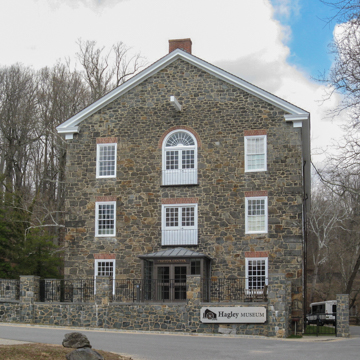Along a scenic stretch of Brandywine Creek, French emigrant Eleuthère Irénée du Pont founded his namesake gunpowder company in 1802. From this seed would grow the gigantic DuPont chemical corporation of our times. E. I. named the first powder yard after himself, Eleutherian Mills, a name preserved today in his house (CH15.4) that stands overlooking the industrial ruins (also known as Upper Yard). Better preserved is the later Hagley Yard downstream (CH15.1), near which stands a small fraction of the worker housing built by the du Ponts. The various yards remained in continuous operation from 1802 until 1921. Some 42 percent of the gunpowder used by the North in the Civil War was produced here. Today, the architectural remains (thirty buildings of the original 100) are open to the public as a 230-acre outdoor museum under the administration of the Eleutherian Mills–Hagley Foundation, established at the time of the company's 150th anniversary in 1952. Historical materials are housed in the Library (1959–1961, Voorhees, Walker, Smith, Smith and Haines). Hagley is a National Historic Landmark.
You are here
Hagley Museum
If SAH Archipedia has been useful to you, please consider supporting it.
SAH Archipedia tells the story of the United States through its buildings, landscapes, and cities. This freely available resource empowers the public with authoritative knowledge that deepens their understanding and appreciation of the built environment. But the Society of Architectural Historians, which created SAH Archipedia with University of Virginia Press, needs your support to maintain the high-caliber research, writing, photography, cartography, editing, design, and programming that make SAH Archipedia a trusted online resource available to all who value the history of place, heritage tourism, and learning.


